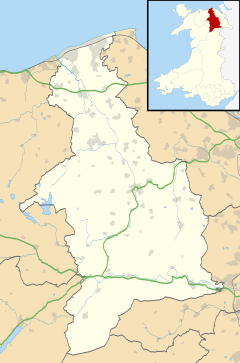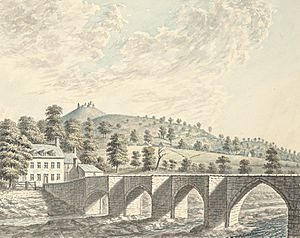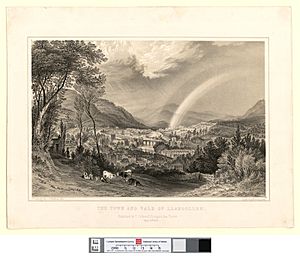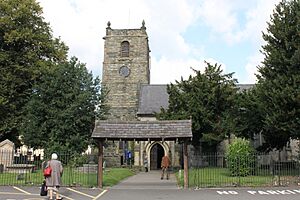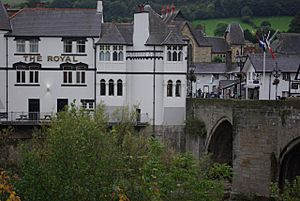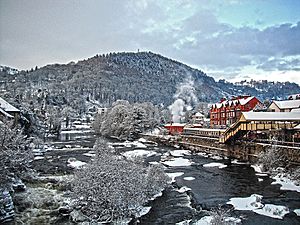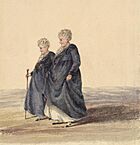Llangollen facts for kids
Quick facts for kids Llangollen |
|
|---|---|
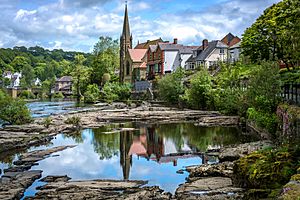 Llangollen Riverside Walk |
|
| Population | 3,658 (2011) |
| OS grid reference | SJ215415 |
| Community |
|
| Principal area | |
| Ceremonial county | |
| Country | Wales |
| Sovereign state | United Kingdom |
| Post town | LLANGOLLEN |
| Postcode district | LL20 |
| Dialling code | 01978 |
| Police | North Wales |
| Fire | North Wales |
| Ambulance | Welsh |
| EU Parliament | Wales |
| UK Parliament |
|
| Welsh Assembly |
|
Llangollen (pronounced Hlan-GOTH-len) is a lovely town in Wales, located right by the River Dee. It's part of Denbighshire county. The town sits at the edge of the Berwyn range of mountains. It is also part of the beautiful Clwydian Range and Dee Valley Area of Outstanding Natural Beauty. In 2011, about 3,658 people lived here.
Contents
Llangollen's Past: A Look at History
Llangollen gets its name from the Welsh word llan, which means "a religious settlement." It's named after Saint Collen, a monk from the 7th century. He built a church next to the river. People say St. Collen arrived in Llangollen in a small boat called a coracle. St Collen’s Church is the only church in Wales named after him.
Above the town to the north, you can see the ruins of Castell Dinas Brân. This was once a strong castle belonging to the Princes of Powys. Beyond the castle are the amazing Eglwyseg Rocks. These are tall cliffs made of limestone. A road north of the castle is called the Panorama Walk. It offers great views.
Long ago, the area of Llangollen was split into three parts called traeanau. Each traean was like a third of the land.
- Llangollen Traean included areas like Bachau and Pengwern.
- Trefor Traean had places such as Cilmediw and Trefor Isaf.
- Glyn Traean contained townships like Cilcochwyn and Talygarth.
Valle Crucis Abbey was built nearby in about 1201. It was supported by Madog ap Gruffydd Maelor from Castell Dinas Brân.
The Historic Llangollen Bridge
The bridge in Llangollen was built over the River Dee in the 1500s. It replaced an older bridge from the 1300s. In the 1860s, the bridge was made longer to cross a new railway. It also had a two-story stone tower. This tower was later removed in the 1930s to help traffic flow better. The bridge was also made wider in 1873 and again in 1968. The new parts were built to match the old stone. It is a very important historical structure.
Plas Newydd and the Ladies of Llangollen
Plas Newydd is a historic house on the edge of town. From 1780, it was the home of the famous Ladies of Llangollen. These were two friends, Sarah Ponsonby and Lady Eleanor Butler. They lived there with their maid, Mary Carryl. They are all buried in the same grave at the church.
Other Historic Sites
The Pillar of Eliseg is another old monument near Valle Crucis Abbey. It's a tall stone pillar with ancient carvings. Llangollen Community Hospital was built in 1876.
Local Government in Llangollen
Llangollen has its own local government called the Llangollen Town Council. They work from the Llangollen Town Hall. The town is also part of an electoral ward for Denbighshire County Council. This ward includes the nearby community of Llantysilio. In 2011, about 4,079 people lived in this ward.
Llangollen's Economy: How People Make a Living
Today, Llangollen mostly depends on tourism. Many visitors come to see the town and its beautiful surroundings. However, farming is still important, especially sheep farming in the hills. For hundreds of years, the local wool industry was a big part of the economy. People spun and wove wool into cloth. Later, factories were built along the River Dee to process both wool and cotton. The old water mill near the Llangollen railway station is over 600 years old. It used to grind flour for local farmers.
Culture and Festivals in Llangollen
In the late 1800s, Llangollen had its own weekly newspaper called the Llangollen Advertiser. The town also hosted the National Eisteddfod in 1908. This is a big Welsh festival of poetry and music. Important people like David Lloyd George and Winston Churchill visited the festival.
Llangollen International Musical Eisteddfod
Llangollen is famous for its annual International Eisteddfod. This is a huge international music festival. It lasts for a week in July. It starts with a big parade where locals and visitors dance, sing, and play music. People come from all over the world to perform and compete.
Llangollen Fringe Festival
The Llangollen Fringe Festival is another arts festival. It usually happens in mid-July at the town hall. The Fringe Festival features music, comedy, theater, dance, and workshops. Many different artists have performed there.
Dee Rocks Music Festival
Dee Rocks is a local music festival that raises money for good causes. It usually takes place in May. The town hall becomes a music venue for this event.
Songs and Rhymes About Llangollen
- "Llangollen Market" is a traditional song.
- "Ladies of Llangollen" is a song by Ian Chesterman.
- "Pastai Fawr Llangollen" (The Great Llangollen Pie) is a Welsh song.
- The bridge over the Dee is one of the Seven Wonders of Wales in an old rhyme.
- The famous nursery rhyme "Mary had a little lamb" is sometimes wrongly linked to Llangollen. The real story happened in the United States.
Getting Around Llangollen: Transport
Llangollen was once an important stop for mail coaches. These were horse-drawn carriages that carried mail and passengers. The old mail route, now the A5 road, went from London to Holyhead.
Bus Services
Several buses serve the town. You can take buses to Wrexham and Barmouth. These buses connect Llangollen to nearby towns with train stations. There's also a special "Dee Valley Picturesque Bus" that runs from April to November. It links Llangollen to popular places like Pontcysyllte Aqueduct, Horseshoe Falls, and Plas Newydd house.
Llangollen Railway
A railway line reached Llangollen in 1865. It was part of the Great Western Railway. However, the line closed in 1965 for passengers and in 1969 for goods. But now, a 10-mile part of the line has been restored. It operates as the Llangollen Railway, which is a popular tourist attraction. You can ride on old steam trains!
Llangollen Canal
The Ellesmere Canal was planned to connect coal mines and ironworks to the sea. The plans changed, and the canal ended up connecting to the national canal network. A special part of the canal, called a feeder canal, was built to bring water from the River Dee at Llantysilio. This part of the canal is now known as the Llangollen Canal.
The canal was important for supplying water to towns like Crewe and Nantwich. Even when boats stopped using it for trade, it was kept open for water supply. The canal has a strong flow of water, up to 2 miles per hour. Today, the canal is very popular for leisure. Many people enjoy boating on it. You can moor your narrowboat in Llangollen or take a horse-drawn boat ride to Horseshoe Falls.
Sports and Activities in Llangollen
Llangollen is a great place for white water sports on the River Dee. It hosts international and UK events for Slalom canoeing and kayaking.
You can also find teams for Cricket, football, and rugby union in Llangollen. They play at Tower Fields, which has views of the town.
The hills around Llangollen are good for paragliding because of the warm air currents. Mountain bikers also enjoy the trails in the hills.
Llangollen was the starting point for the first mass-start bicycle race on British roads, back in 1942.
Famous People from Llangollen
- Gruffudd Hiraethog (died 1564), a Welsh poet.
- Huw Morus (1622–1709), a Welsh poet known as Eos Ceiriog (the nightingale of Ceiriog).
- The Ladies of Llangollen, Eleanor Butler (1739–1829) and Sarah Ponsonby (1755–1831), who were famous for living together at Plas Newydd.
- Garner Evans (1910–1963), a politician who was a Member of Parliament for Denbigh.
- Jonathan Rogers (1920–1964), a sailor who received the George Cross award.
- Glyn James (born 1941), a footballer who played for Blackpool F.C. and the Wales national team.
See also
 In Spanish: Llangollen para niños
In Spanish: Llangollen para niños


